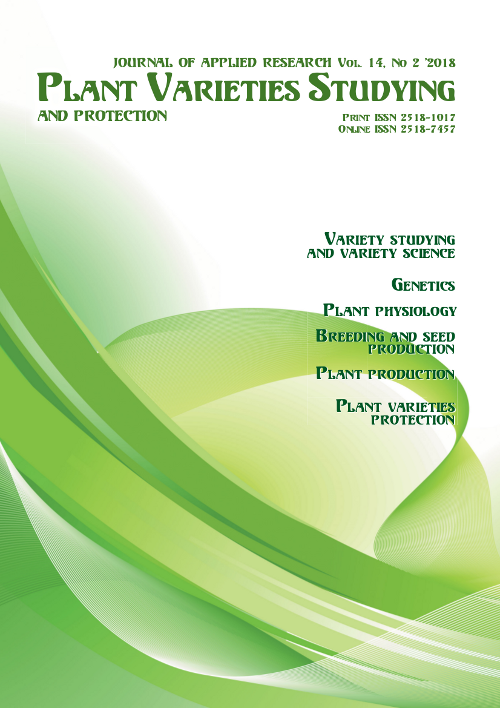Comparative analysis of methodological approaches to morphological description of plant varieties in Ukraine and European Union countries
DOI:
https://doi.org/10.21498/2518-1017.14.2.2018.134777Keywords:
EU documents in the field of protection of rights to plant varieties, UPOV technical documents, CPVO regulations, directives and protocols, methods, botanical taxonAbstract
Purpuse. To develop scientific and methodological principles of legal protection of plant varieties in Ukraine in accordance with the requirements of the Community Plant Variety Office (CPVO) and the European Union (EU), to analyze the relevant methodological and legal norms and approaches aimed to improve the system of legal protection of plant varieties as intellectual property objects identified during the expert determination the criteria for distinctiveness, uniformity and stability (DUS-test).
Results. Determination of the criteria for distinctiveness, uniformity and stability implies the plant varieties identification by the method of phenotype morphological description (the signs of vegetative and generative organs). The morphological code formula of the variety consists of the corresponding codes of the sign and the degree of its expression that is formed according to the technical documents and DUS methods in all countries of the International Union for the Protection of New Varieties of Plants (UPOV) and CPVO. Methodological provision for the protection of breeder’s rights and new plant varieties in the EU and the CPVO protocols were analyzed by the comparative method of the general parts and the tables of signs of DUS techniques for the botanical taxons of 4 plant groups: agricultural, vegetable, fruit and decorative.
Conclusions. As a result of comparative assessment of DUS methods for plant varieties (CPVO – Protocols, UPOV – TG, Ukraine – UATG) was found that the morphological description of plant varieties during the field trials (qualitative (QL), quantitative (QN) and pseudo-qualitative (PQ) signs of phenotypes ) is the basic technique for conducting DUS testing according to the international UPOV requirements as well as to CPVO requirements. National Methods for Plant Varieties Examination for Distinctness, Uniformity and Stability are developed under mandatory requirements of the DOCUMENT TGP 7/3 DEVELOPMENT OF TEST GUIDELINES adopted by the Council at its forty-eighth ordinary session on October 16, 2014. The CPVO and EU methodological bases at the 2015 research stage included protocols for 160 botanical taxons, represented by four plant groups: agricultural (18); vegetables (46); fruit (30) and decorative (66). The CPVO protocols for 122 botanical taxons, namely: agricultural (18), vegetable (44); fruit (28) and decorative (32) are of great value for the application’s scientific and technical examination for plant variety registration inUkraine. Field tests of plant phenotypes in accordance with morpho-descriptive method for variety identification by the relevant features and their degree of expression for harmonized description of plant varieties is practically brought to the UPOV international requirements and partly to CPVO protocols of the European Union.
Downloads
References
Mizhnarodna Konventsiia z okhorony novykh sortiv roslyn vid 2 hrudnia 1961 r., perehlianuta v m. Zheneva 10 lystopada 1972 r., 23 zhovtnia 1978 r. ta 19 bereznia 1991 r. [International Convention for the Protection of New Varieties of Plants dated December 2, 1961, revised in Geneva on November 10, 1972, October 23, 1978, and March 19, 1991]. (2006). Kyiv: Alefa [in Ukrainian]
Drobiazko, V. (2006). The right of intellectual property in the European Union. Pytannia intelektualnoi vlasnosti [Intellectual Property Issues], 4, 66–113. [in Ukrainian]
Rudenko, O. V. (2003). Unification of the copyright norms in the EU Directives. Naukovyi Visnyk Chernivetskoho Universitetu. Pravoznavstvo [Scientific Bulletin of Chernivtsi University. Jurisprudence], 180, 68–72. [in Ukrainian]
Kapitsa, Yu. M. (2005). Enforcement of Intellectual Property Rights in the European Union. Intelektualnyi capital [Intellectual Capital], 4, 3–11. [in Ukrainian]
Council Regulation (EC) No 2100/94 of 27 July 1994 on Community plant variety rights. Retrieved from http://www.upov.int/upovlex/en/details.jsp?id=10906
Orliuk, O. P. (Ed.). (2010). Pravove zabezpechennia sfery intelektualnoi vlasnosti v Ukraini v konteksti Yevropeiskoi intehratsii: kontseptualni zasady [Legal support of intellectual property inUkraine in the context of European integration: conceptual foundations]. Kyiv: Lazuryt-Polihraf. [in Ukrainian]
Document TGP/7 development of test guidelines adopted by the Council at its forty-eighth ordinary session on October 16, 2014. Retrieved from http://www.upov.int/edocs/tgpdocs/en/tgp_7.pdf
List all Test Guidelines by TG. Retrieved from http://www.upov.int/test_guidelines/en/list.jsp
Technical protocols of CPVO. Retrieved from http://cpvo.europa.eu/en/applications-and-examinations/technical-examinations/technical-protocols
Downloads
Published
How to Cite
Issue
Section
License
Copyright (c) 2018 Ukrainian Institute for Plant Variety Examination

This work is licensed under a Creative Commons Attribution-ShareAlike 4.0 International License.
Starting in 2022, the copyright to the publication remains with the authors
Our journal abides by the CREATIVE COMMONS copyright rights and permissions for open access journals.
Authors, who are published in this journal, agree to the following conditions:
- The authors reserve the right to authorship of the work and pass the first publication right of this work to the journal under the terms of a Creative Commons Attribution License, which allows others to freely distribute the published research with the obligatory reference to the authors of the original work and the first publication of the work in this journal.
- The authors have the right to conclude separate supplement agreements that relate to non-exclusive work distribution in the form in which it has been published by the journal (for example, to upload the work to the online storage of the journal or publish it as part of a monograph), provided that the reference to the first publication of the work in this journal is included.

























 Ukrainian Institute for Plant Varieties Examination
Ukrainian Institute for Plant Varieties Examination  Селекційно-генетичний інститут
Селекційно-генетичний інститут Institute of Plant Physiology and Genetics of the National Academy of Sciences of Ukraine
Institute of Plant Physiology and Genetics of the National Academy of Sciences of Ukraine
 The National Academy of Agrarian Sciences of Ukraine
The National Academy of Agrarian Sciences of Ukraine